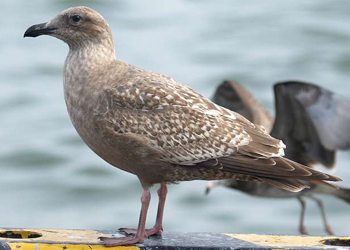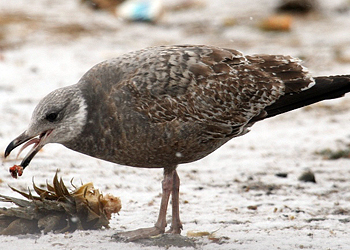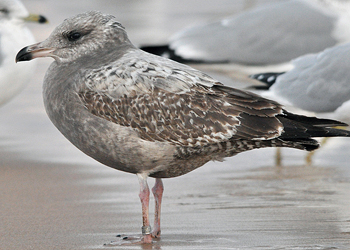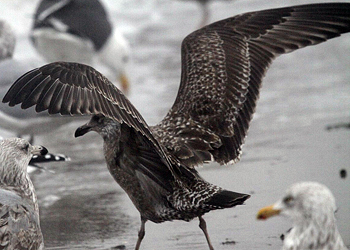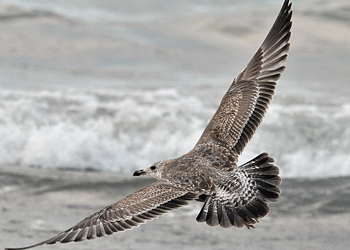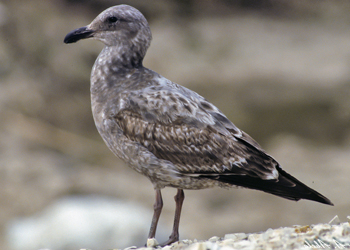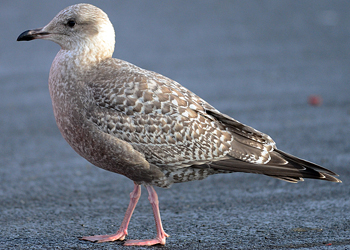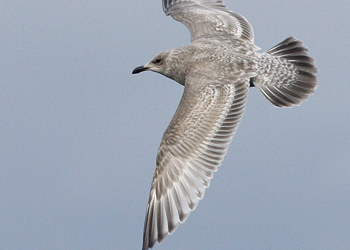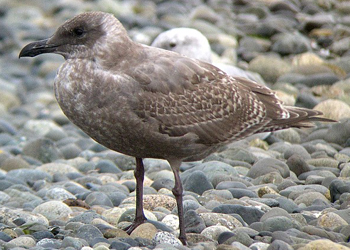 Slaty-backed Gull (schistisagus) / オオセグロカモメ / 큰재갈매기
Slaty-backed Gull (schistisagus) / オオセグロカモメ / 큰재갈매기
(last update: December 2015)
Slaty-backed Gull (schistisagus) sub-adult March
The immature birds on this page comprise two age classes: 3rd cycle (4CY March) birds and 4th cycle (5CY March) birds. Many birds can be aged correctly by combining adult-like and immature characteristics, however some retarded 4th cycle birds or advanced 3rd cycle birds are labelled "sub-adult".
3rd generation flight feathers in 3rd cycle birds. In general these are adult-like birds, with obvious immature markings. Ageing can be difficult at this age, especially between 3rd cycle and 4th cycle birds. Immature birds with extensive black in the tail and extensive brown wing-covert patches should normally also be in 3rd cycle. However, advanced 3rd cycle and retarded 4th cycle birds are extremely similar, and such birds are probably best labelled "sub-adult".
4th cycle birds are very adult-like, with single vestiges of immaturity, like dark centres on underwing primary coverts, dark centres in some secondaries or some black in the tail feathers. Remember that true adult Slaty-backed Gulls hardly develop black on the bill, hence birds that do show a black line on the bill are suspecious and should be checked for any immature characteristics (check white underwing on dark scalloped patterns!).
= = = = = = = = = = = = = = = = = = = = = = = = = = = = = = = = = = = = = = = = = = = = = = = = =
Below you will find a description of Chapter 30. SLATY-BACKED GULL, as published in one of the best Gull publication: "Gulls of the Americas" by Steve Howell & Jon Dunn.
"we" in the text below refers to the original authors. If any errors occur in this text, please let me know and mail to marsmuusseatgmaildotcom.
= = = = = = = = = = = = = = = = = = = = = = = = = = = = = = = = = = = = = = = = = = = = = = = = =
BACK TO PART 1: STATUS & DISTRIBUTION
BACK TO PART 2: FIELD IDENTIFICATION, SIMILAR SPECIES - ADULT CYCLE
BELOW: FIELD IDENTIFICATION, SIMILAR SPECIES - FIRST CYCLE
For Slaty-backed Gull, note overall size and structure, bill size and shape, two-tone pattern of outer primaries, relatively plain greater coverts.
VEGA GULL less thickset with narrower and relatively longer wings, less stout bill typically dull pinkish at base; some birds may overlap in size an d overall shape with Slaty-backed. Plumage generally has more-contrasting patterning, notably, on greater coverts; tail base whiter with narrower and blacker distal band; A1 scapulars neatly marked with bars and anchor patterns; outer primaries darker on inner webs, so spread wingtips lack pale tongues of Slaty-backed. Bleached first-summer Vega Gulls often have blacker tertials; note scapular and tail patterns.
AMERICAN HERRING GULL (widespread) averages less thickset with narrower and relatively longer wings, averages less stout bill that is typically dull pinkish at base. Plumage generally darker and browner with bolder pale patterning, strongly barred tail coverts; outer primaries darker on inner webs, so spread wingtips lack pale tongues of Slaty-backed.
WESTERN GULL averages more thickset with more bulbous-tipped bill, plumage darker and browner overall, darker upperwings lack pale panel on inner to middle primaries, tail more solidly blackish.
THAYER’S GULL (w. N. America) smaller and more lightly built with narrower wings and smaller, less stout bill, shorter legs. Upperparts overall more brightly and boldly patterned. Wing and tail patterns similar to Slaty-backed but tail browner, and dark/light contrast on outer primaries averages stronger at shaft.
HYBRID GLAUCOUS-WINGED GULL X AMERICAN HERRING GULL = "COOK INLET GULL" (w. N. America). Slaty-backed upperwing typically has relatively plain and pale greater coverts, contrastingly pale inner primaries, and more distinct inner web/outer web contrast on the outer primaries (at least in fresh plumage), but these features may be matched on hybrids; deep pink legs of some Slaty-backeds may be outside range of hybrids. Field characters need study.
HYBRID GLAUCOUS-WINGED GULL X WESTERN GULL = "OLYMPIC GULL" averages bulkier and broader winged, with a more bulbous-tipped bill. Hybrids typically have more distinctly patterned greater coverts, less contrasting pale panel on inner primaries, and more uniformly dark tail.
CONTINUE PART 4: FIELD IDENTIFICATION, SIMILAR SPECIES - SECOND CYCLE
 Slaty-backed Gull (schistisagus) 3rd cycle (4CY), March 13 2010, Nemuro, Hokkaido, Japan. Picture: Shiroto.
Slaty-backed Gull (schistisagus) 3rd cycle (4CY), March 13 2010, Nemuro, Hokkaido, Japan. Picture: Shiroto. Slaty-backed Gull (schistisagus) 3rd cycle (4CY), March 15 2010, Nemuro, Hokkaido, Japan. Picture: Shiroto.
Slaty-backed Gull (schistisagus) 3rd cycle (4CY), March 15 2010, Nemuro, Hokkaido, Japan. Picture: Shiroto. Slaty-backed Gull (schistisagus) 3rd cycle (4CY), March 03 2010, Shibetsu, Hokkaido, Japan. Picture: Shiroto.
Slaty-backed Gull (schistisagus) 3rd cycle (4CY), March 03 2010, Shibetsu, Hokkaido, Japan. Picture: Shiroto. Slaty-backed Gull (schistisagus) 3rd cycle (4CY), March 18 2010, Nemuro, Hokkaido, Japan. Picture: Shiroto.
Slaty-backed Gull (schistisagus) 3rd cycle (4CY), March 18 2010, Nemuro, Hokkaido, Japan. Picture: Shiroto. Slaty-backed Gull (schistisagus) 3rd cycle (4CY), March 13 2010, Nemuro, Hokkaido, Japan. Picture: Shiroto.
Slaty-backed Gull (schistisagus) 3rd cycle (4CY), March 13 2010, Nemuro, Hokkaido, Japan. Picture: Shiroto. Slaty-backed Gull (schistisagus) 3rd cycle (4CY), March 13 2010, Nemuro, Hokkaido, Japan. Picture: Shiroto.
Slaty-backed Gull (schistisagus) 3rd cycle (4CY), March 13 2010, Nemuro, Hokkaido, Japan. Picture: Shiroto. Slaty-backed Gull (schistisagus) 3rd cycle (4CY), March 11 2012, Choshi, Japan. Picture: Peter Adriaens.
Slaty-backed Gull (schistisagus) 3rd cycle (4CY), March 11 2012, Choshi, Japan. Picture: Peter Adriaens.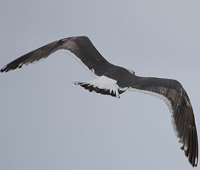 Slaty-backed Gull (schistisagus) 3rd cycle (4CY), March 06 2012, Choshi, Japan. Picture: Peter Adriaens.
Slaty-backed Gull (schistisagus) 3rd cycle (4CY), March 06 2012, Choshi, Japan. Picture: Peter Adriaens.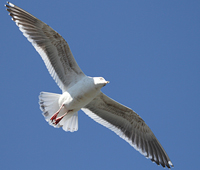 Slaty-backed Gull (schistisagus) 3rd cycle (4CY), March 12 2012, Choshi, Japan. Picture: Peter Adriaens.
Slaty-backed Gull (schistisagus) 3rd cycle (4CY), March 12 2012, Choshi, Japan. Picture: Peter Adriaens.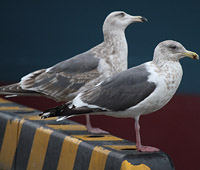 Slaty-backed Gull (schistisagus) sub-adult, March 07 2012, Choshi, Japan. Picture: Peter Adriaens.
Slaty-backed Gull (schistisagus) sub-adult, March 07 2012, Choshi, Japan. Picture: Peter Adriaens. Slaty-backed Gull (schistisagus) 4th cycle (5CY), March 28 2008, Nemuro, Hokkaido, Japan. Picture: Shiroto.
Slaty-backed Gull (schistisagus) 4th cycle (5CY), March 28 2008, Nemuro, Hokkaido, Japan. Picture: Shiroto. Slaty-backed Gull (schistisagus) 4th cycle (5CY), March 13 2010, Nemuro, Hokkaido, Japan. Picture: Shiroto.
Slaty-backed Gull (schistisagus) 4th cycle (5CY), March 13 2010, Nemuro, Hokkaido, Japan. Picture: Shiroto. Slaty-backed Gull (schistisagus) 4th cycle (5CY), March 13 2010, Nemuro, Hokkaido, Japan. Picture: Shiroto.
Slaty-backed Gull (schistisagus) 4th cycle (5CY), March 13 2010, Nemuro, Hokkaido, Japan. Picture: Shiroto.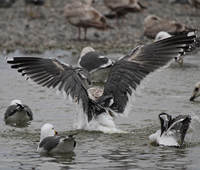 Slaty-backed Gull (schistisagus) sub-adult, March 07 2012, Choshi, Japan. Picture: Peter Adriaens.
Slaty-backed Gull (schistisagus) sub-adult, March 07 2012, Choshi, Japan. Picture: Peter Adriaens. Slaty-backed Gull (schistisagus) 4th cycle (5CY), March 13 2010, Nemuro, Hokkaido, Japan. Picture: Shiroto.
Slaty-backed Gull (schistisagus) 4th cycle (5CY), March 13 2010, Nemuro, Hokkaido, Japan. Picture: Shiroto.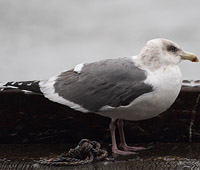 Slaty-backed Gull (schistisagus) sub-adult, March 10 2012, Choshi, Japan. Picture: Peter Adriaens.
Slaty-backed Gull (schistisagus) sub-adult, March 10 2012, Choshi, Japan. Picture: Peter Adriaens.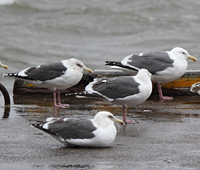 Slaty-backed Gull (schistisagus) sub-adult, March 10 2012, Choshi, Japan. Picture: Peter Adriaens.
Slaty-backed Gull (schistisagus) sub-adult, March 10 2012, Choshi, Japan. Picture: Peter Adriaens.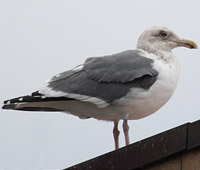 Slaty-backed Gull (schistisagus) sub-adult, March 07 2012, Choshi, Japan. Picture: Peter Adriaens.
Slaty-backed Gull (schistisagus) sub-adult, March 07 2012, Choshi, Japan. Picture: Peter Adriaens.